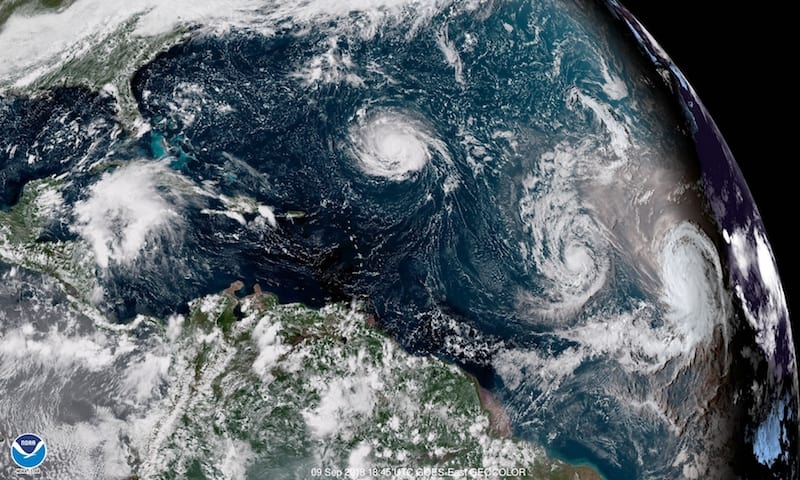
NOAA Satellite Image
Bookmark this page for quick access to resources for emergency preparedness in the Triangle. These resources can help you get prepared before an emergency occurs and after disaster strikes.
Hurricane Watches and Warnings
Here’s what to do in the cases of hurricane watches and warnings, as well as in the case when officials indicate that evacuation is necessary. (Not likely for us, but good information to have.)
Hurricane Watches
A Hurricane Watch is issued when there is a threat of hurricane conditions within 24-36 hours.
- Listen to a battery-operated radio or television for hurricane progress reports.
- Check emergency supplies. (See below.)
- Fuel car.
- Bring in outdoor objects such as lawn furniture, toys, and garden tools and anchor objects that cannot be brought inside.
- Secure buildings by closing and boarding up windows. Remove outside antennas.
- Turn refrigerator and freezer to coldest settings. Open only when absolutely necessary and close quickly.
- Store drinking water in clean bathtubs, jugs, bottles, and cooking utensils.
- Store valuables and personal papers in a waterproof container on the highest level of your home.
- Review evacuation plan.
- Moor boat securely or move it to a designated safe place. Use rope or chain to secure boat to trailer. Use tie-downs to anchor trailer to the ground or house.
Hurricane Warnings
A Hurricane Warning is issued when hurricane conditions (winds of 74 miles per hour or greater, or dangerously high water and rough seas) are expected in 24 hours or less.
- Listen constantly to a battery-operated radio or television for official instructions.
- If in a mobile home, check tie-downs and evacuate immediately.
- Avoid elevators.
- Stay inside, away from windows, skylights, and glass doors.
- Keep a supply of flashlights and extra batteries handy. Avoid open flames, such as candles and kerosene lamps, as a source of light.
- If power is lost, turn off major appliances to reduce power “surge” when electricity is restored
If officials indicate evacuation is necessary
- Leave as soon as possible. Avoid flooded roads and watch for washed-out bridges. Cars can become buoyant when water depth reaches one foot, and velocities of 8 to 10 feet per second will sweep a person off of their feet.
- Secure your home by unplugging appliances and turning off electricity and the main water valve.
- Tell someone outside of the storm area where you are going.
- If time permits, and you live in an identified surge zone, elevate furniture to protect it from flooding or better yet, move it to a higher floor.
- Take pre-assembled emergency supplies, warm protective clothing, blankets and sleeping bags to shelter.
- Lock up home and leave.
City, Town and County Emergency Resources
This emergency preparedness information includes links to local and national emergency preparedness resources containing helpful information for developing an emergency plan, a checklist for creating a plan including disaster kits and “go” bags, and other information to help you prepare for hurricanes, floods, stormy weather, and other potential disasters in the Triangle.
It’s a good idea to visit the page for the area you’re in before disaster strikes. Many have alert systems that you can sign up for.
- City of Raleigh Emergency Preparedness
- Wake County Emergency Management
- Durham Emergency Management
- Town of Chapel Hill Emergency
- Town of Carrboro Emergency Planning
- Chatham County Emergency Management
North Carolina and United States Emergency Resources
The following resources can help anyone in the state of North Carolina prepare for or get help after emergencies and natural disasters.
- North Carolina Department of Public safety Emergency Management
- ReadyNC Hurricane Plan
- National Weather Service
Emergency Preparedness Plans
To help you get started, here are the basic steps you need to complete in order to develop an emergency preparedness plan.
- Create a family emergency plan: where to go, what to do, and how to reconnect.
- Know your evacuation routes (in case of fire, flood, earthquake, etc.)
- Include a pet emergency plan if needed, such as when you need to go to a shelter where pets are not accepted.
- Create one or more emergency kits. (See below.)
Emergency Kits
It’s recommended to pack emergency supplies into one or more emergency kits. For example, you might have a 3-day evacuation supply for yourself in a bag in the car or office (or both), and a 2-week supply at home for every member of your household.
This is not a complete list, but a starting point. Review the above resources and adapt the list to suit your family needs and living situation.
Make sure to review and replenish your kit once or twice a year. Daylight savings time changes are easy to remember, when you are (hopefully) also changing the batteries in your home smoke detectors. Or make emergency kit supplies a family activity to review around the holidays and before summer vacations.
Emergency Kit supplies to replenish every 6 to 12 months
These items are more perishable than other emergency kit supplies, so need to be checked and replenished regularly. I find it easiest to simply rotate these supplies any time I need to buy a household product, by replenishing the emergency kit first and rotating kit items to the household supply.
- Water: one gallon per person (and pet), per day. Half of the supply can be for non-drinking purposes, such as washing and toilets, by filling large (5 gallon) containers from the garden hose. Or just fill up a tub with water for non-drinking purposes. Even for drinking purposes, you don’t need to buy bottled water. You can fill up pitchers, refillable water bottles, clean buckets, etc. prior to the arrival of the hurricane.
- A tip from a Triangle on the Cheap reader: “We are refilling our bottles this week with the filtered water from the refrigerator and filling our freezer with them, It will give us ice and after if melts we will have drinking water.”
- Food (non-perishable, no cook, or easy-to-prepare items), such as: ready-to-eat canned meats, fish, beans, soup, stew, fruits, and vegetables. Be sure to add a can opener to your kit. Other types of useful products include protein bars, dry cereal or granola with nuts and dried fruit, peanut butter, dried fruit, and canned or boxed milk. Don’t forget pet foods or family members with special dietary needs, including infants.
- First aid kit: you can buy first aid kits at most drugstores or outdoor recreation stores, or simply assemble supplies on your own. I’ve done a little of both.
- Medications should be part of your emergency kit for you or any family member who requires a prescription or regular medical care.
- Personal hygiene items, including: travel size toothbrush and toothpaste, travel size shampoo, hand/body wipes or towelettes, deodorant, razor and shaving cream for men, and sanitary napkins or tampons for women. Sanitary napkins can also be used for first aid to control bleeding.
- Batteries for any item in your kit, such as a flashlight or radio.
- Miscellaneous supplies: A small bottle of bleach and zipper style and/or plastic trash bags.
Emergency Kit items to review and replace as needed
These items don’t expire, but should be replaced if they become inoperable or your needs or family information changes.
- Flashlight, battery-powered or hand-crank, and/or light sticks
- Radio (preferably a NOAA Weather Radio), battery-powered or hand-crank
- Multi-purpose tool (such as Leatherman or Swiss Army multi-tool)
- Cell phone with charger
- Portable toilet (bucket, plastic bags, toilet paper)
- Copies of important documents, such as medication list, medical information, proof of address, deed/lease to home, passports, birth certificates, or insurance policies
- Family and emergency contact information
- Extra cash (small bills: $1, $5, or $10)
- Emergency blanket, hand warmers
- Extra clothes, per person (such as sweat pants, hoodie, underwear, socks, and shoes)
- Maps of the area

